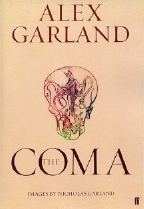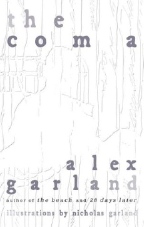The Coma
Faber & Faber
UK Hardcover First
ISBN 0-571-22308-7
Publication Date: 07-01-2004
168 Pages; £16.99
|

|
The Coma
Riverhead Books
US Hardcover First
ISBN 1-573-22273-9
Publication Date: 07-01-2004
144 pages; $19.95
|

|
Date Reviewed: 06-17-04
Reviewed by Rick Kleffel © 2004
|
|
|
REFERENCES
|
COLUMNS
|
|
General
Fiction, Horror
|
|
[Readers may be interested in first seeing a preview of
the book with large scans of the woodcuts.]
The most difficult effect for a writer to achieve is simplicity.
The clarity, the transparency that results from simplicity pulls
readers relentlessly into a narrative, and enables the writer to get
direct access to the reader's emotions. Alex Garland manages to get
out of his own way and stay out of his own way in the clever and
chilling short novel 'The Coma'. Aided by 40 woodcut illustrations
done by his father, Garland takes on an idea that's been done a
million times by many a famous writer. Is the character awake or
asleep, alive or dead, seeing or dreaming? It's a dangerous business
to visit ground that's as heavily trafficked as this. Garland treads
lightly, pays attention to the characters and gets the details
blurrily right. His prose is so readable and his story so nicely
compacted that readers will want to -- and be able to -- read it in
one sitting. And that's good because once they've finished, they'll
want to read it again -- and be both willing and able to.
The plot is nearly as thin as the novel. Carl works late at the
office, and finds himself alone on the tube with a woman -- until
they're both joined by a group of thugs. When the hoodlums menace the
woman, Carl steps in and gets stepped on. The last thing he remembers
before passing out is getting pummeled. Then -- the hospital bed. Or
is it?
Chapters in 'The Coma' are one or two pages, and each chapter is
accompanied by one of Garland senior's woodcuts. The illustrations
are creepy and effective, bolstering the mood of the prose. As it
becomes clear that Carl has not wakened but is still in a coma,
Garland has his character confront this situation head-on. There's no
maybe about it, Carl knows he is in a coma and knows that he must
wake up. Trapped in a world of his own creation, the fear begins to
seep from the pitch-black pictures into the character -- and thence
into the reader.
By keeping matters simple, Garland manages to evoke a number of
very effective chills. He swiftly bangs the lid shut on Carl's mental
jail and the reader can hear the ringing bars. What Garland is after
here -- and actually manages to get -- is the universal sense of
mental claustrophobia. Ultimately, we're all stuck with and in
ourselves. Garland's surreal juxtapositions of time and space, the
lacunae that Carl experiences serve to remind the reader of how
precious and fragile our sense of self is. In many ways, this book is
the rather safer equivalent of experiencing a particularly bad but
mundane drug-induced hallucination. Oh, Carl is hallucinating all
right, but it's not pink elephants or gray aliens. He may be
hallucinating that he's alive. Garland knows how to prick the skin
and send a chill deep into the reader's sense of self.
Pacing is an essential tool that Garland uses quite effectively in
'The Coma'. By writing in such short chapters, and by breaking up the
text with the woodcuts, he manages to, on one hand, make the book
easier to read in one sitting, but on the other hand, break up the
reader's and the character's consciousness. Plus, if you're writing
an entire novel about someone who is very likely to be in a coma, it
helps to prevent your reader from plunging into a coma. Reading about
someone else sleeping and hallucinating is not interesting in and of
itself. Only good writing can make that happen, and Garland writes
well enough to keep the reader riveted.
This is not to say that the novel is utterly perfect. In reaching
for a dream-like state, Garland on occasion leaves the edges a little
too blurred. More than a few readers might react to this novel by
wondering what the heck exactly happened, though to my mind, it's
fairly apparent. Garland does not waste a single word in this
concise novel. Even random spew, supposedly the result of a disordered
mind, is telling the reader something. Many readers will pass it by; I did.
But on second look, it is fairly obvious; not only are you given very
few supposedly random words in an otherwise tight novel, you are given the means
of decoding them the first time you encounter them, if you read carefully
enough. After all, Lexicons Often Offer Kafkaesque Adaptations To The Habitual
Eager Fan, Interested Readers, Scholarly Taxonomists, Lazy Economists, Then To Every Reader.
You'll be
forgiven
for
not doing so, however.
But the point is that even if you don't know
precisely what happened, you certainly will know you had a great time
reading about it. And without a doubt, Garland will certainly bring a
chill and scare you with the good old specter of mental illness.
There's actually quite a large literature of amnesia and mental
dislocation. But few writers have taken as admirably a
straightforward approach as Garland. The ambiguity of this type of
story is handled here by those woodcuts and they are alternately
humorous and horrific, their simplicity mirroring the simplicity of
the prose. But there's no getting around the subtle chill that a big
black patch of ink can create, and some of the simple, stark images
here are as frightening as an entire gallery of clown portraits.
Ultimately, for some, 'The Coma' may prove to be too simple for
its own good. But there's no denying that Garland has managed to
re-invent the wheel -- or in this case, the coma novel. He takes a
premise that we've all read or seen before and reworks it in his own
words, words that are always a pleasure to read. And it's quite
interesting to read a novel, which helps the readers escape their own
perception, about the basic human inability to escape our own
perception. We're all trapped in ourselves. Unless of course, we're
glued to the pages of 'The Coma', in which case, we're trapped in
someone else. Who himself is trapped. Like any great novel, 'The
Coma' leads us back to ourselves.

